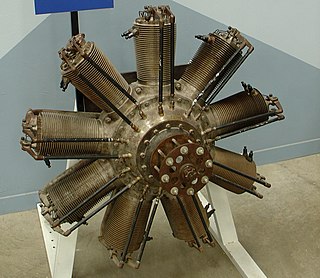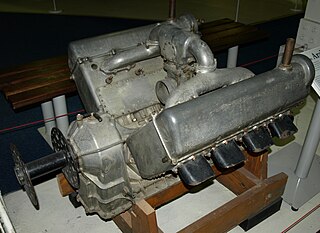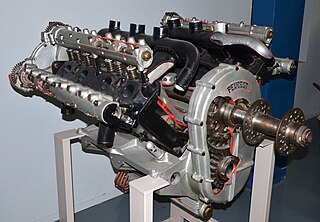
The Hispano-Suiza 12Y was an aircraft engine produced by Hispano-Suiza for the French Air Force before the Second World War. The 12Y became the primary French 1,000 hp (750 kW) class engine and was used in a number of famous aircraft, including the Morane-Saulnier M.S.406 and Dewoitine D.520.

The Sopwith T.1 Cuckoo was a British biplane torpedo bomber used by the Royal Naval Air Service (RNAS), and its successor organization, the Royal Air Force (RAF). The T.1 was the first landplane specifically designed for carrier operations, but it was completed too late for service in the First World War. After the Armistice, the T.1 was named the Cuckoo.

The Royal Aircraft Factory S.E.5 is a British biplane fighter aircraft of the First World War. It was developed at the Royal Aircraft Factory by a team consisting of Henry Folland, John Kenworthy and Major Frank Goodden. It was one of the fastest aircraft of the war, while being both stable and relatively manoeuvrable. According to aviation author Robert Jackson, the S.E.5 was: "the nimble fighter that has since been described as the 'Spitfire of World War One'".

The Hispano-Suiza 8 is a water-cooled V8 SOHC aero engine introduced by Hispano-Suiza in 1914 that went on to become the most commonly used liquid-cooled engine in the aircraft of the Entente Powers during the First World War. The original Hispano-Suiza 8A was rated at 140 hp (100 kW) and the later, larger displacement Hispano-Suiza 8F reached 330 hp (250 kW).

Clerget was the name given to a series of early rotary aircraft engine types of the World War I era that were designed by Pierre Clerget(fr). Manufactured in France by Clerget-Blin and in Great Britain by Gwynnes Limited they were used on such aircraft as the Sopwith Camel and Vickers Gunbus.

The Rolls-Royce Eagle was the first aircraft engine to be developed by Rolls-Royce Limited. Introduced in 1915 to meet British military requirements during World War I, it was used to power the Handley Page Type O bombers and a number of other military aircraft.

The Rolls-Royce Eagle Mk XXII is a British 24-cylinder, sleeve valve, H-block aero engine of 46 litre displacement. It was designed and built in the early-1940s by Rolls-Royce Limited and first ran in 1944. It was liquid-cooled, of flat H configuration with two crankshafts and was capable of 3,200 horsepower at 18 psi boost.

The Sunbeam Arab was a British First World War-era aero engine.

The de Havilland Gipsy Queen is a British six-cylinder aero engine of 9.2 litres (560 cu in) capacity that was developed in 1936 by the de Havilland Engine Company. It was developed from the de Havilland Gipsy Six for military aircraft use. Produced between 1936 and 1950 Gipsy Queen engines still power vintage de Havilland aircraft types today.

The Le Rhône 9J is a nine-cylinder rotary aircraft engine produced in France by Gnome et Rhône. Also known as the Le Rhône 110 hp in a reference to its nominal power rating, the engine was fitted to a number of military aircraft types of the First World War. Le Rhône 9J engines were produced under license in Great Britain by W.H. Allen Son & Company of Bedford, and in Germany by Motorenfabrik Oberursel where it was sold as the Oberursel Ur.II.
The Sunbeam Crusader, originally known as the Sunbeam 150 hp, Sunbeam 110 hp or Sunbeam 100 hp, was an early British, side-valve, water-cooled, V-8 aero engine first marketed in 1913.

The Klimov M-103 is a V12 liquid-cooled piston aircraft engine used by Soviet aircraft during World War II.

The ABC Wasp was an experimental 170 hp (127 kW) seven-cylinder radial engine designed by the noted British engineer Granville Bradshaw, and primarily built by ABC Motors Limited. An order for twelve experimental ABC Wasp engines was placed with Guy Motors on 19 April 1918. Eight ABC Wasp engines were made by Crossley Motors Ltd of Manchester, England.

The Clerget 9B is a nine-cylinder rotary aircraft engine of the World War I era designed by Pierre Clerget. Manufactured in both France and Great Britain, it was used on such aircraft as the Sopwith Camel. The Clerget 9Bf was an increased stroke version.

The RAF 4 is a British air-cooled, V12 engine developed for aircraft use during World War I. Based on the eight–cylinder RAF 1 it was designed by the Royal Aircraft Factory but produced by the two British companies of Daimler and Siddeley-Deasy. The RAF 5 was a pusher version of the same engine.

The RAF 3 is a British liquid-cooled, V-12 engine developed for aircraft use during World War I. Based on the eight–cylinder RAF 1 it was designed by the Royal Aircraft Factory but produced by the two British companies of Armstrong Whitworth and Napier & Son. The RAF 7 was a high compression version of the same engine.
The Clerget 11Eb was an 11-cylinder rotary aircraft engine of the World War I era designed by Pierre Clerget. Powering Sopwith types it was nominally rated at 200 horsepower (150 kW).

The Clerget 7Z was a seven-cylinder rotary aircraft engine of the World War I era designed by Pierre Clerget. First appearing in 1913 it was nominally rated at 80 horsepower (60 kW). In addition to the 600 engines built in France by Clerget-Blin, 347 examples were built under license in Britain by Gordon Watney & Co Ltd of Weybridge and Gwynnes Limited of Hammersmith.

The Peugeot 8Aa, or L112, is a water-cooled V8 aircraft engine that equipped the Voisin VIII bombers and escort fighters built during World War I.

















